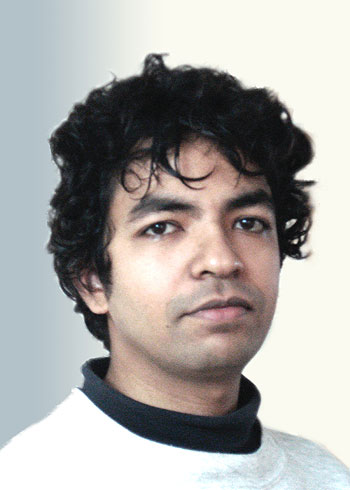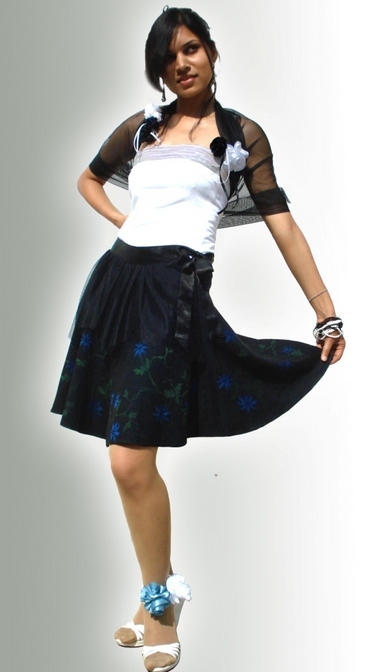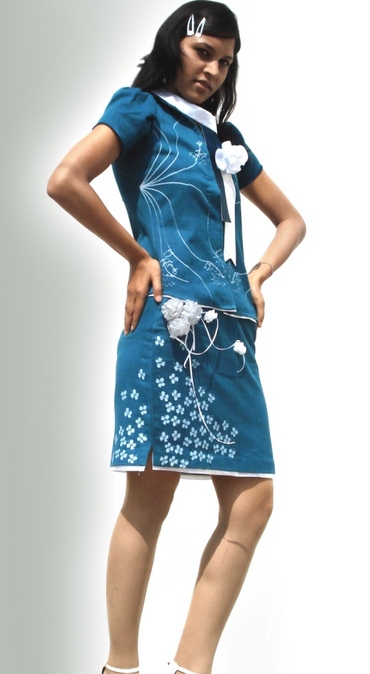
Fashion technologist and designer Siddhartha Upadhyaya is 25 years old. His unkempt hair and aloofness set him apart from the rest of the fashion fraternity famous for air kissing and schmoozing at the first given opportunity. Upadhyaya may not have the "polish" of some of his contemporaries who made their debut along with him at the Lakme Fashion Week in early March. But there is a lot more than what meets the eye with this low-profile designer.
For instance, his was the only eco-friendly line on sale other than Laconet Hemant's at the fashion week. Upadhyaya who is based in New Delhi also has another unique distinction -- some of his clothes have been made on a machine he invented.
DPOL or Direct Printing on Loom is Siddhartha Upadhyaya's patented design that simply needs to be attached to a loom and fed with a design of the garment. Panels of the garment will be printed out on a fabric. And like a DIY kit the garment could be stitched together by anyone with basic sewing skills.
This first-of-its-kind design has earned a place in the London Museum of Arts and promises to reduce cloth wastage and save water by over 20 per cent.
Here the designer tells Abhishek Mande of the stiff opposition he faced at his alma mater, National Institute of Fashion Technology (NIFT) in Bangalore and that it makes sense to save water (nearly 2700 litres are used in the making of one shirt):
DPOL (or Direct Printing on Loom) is a machine I developed to produce sustainable garments. This means that when you use DPOL, there is very little garment wastage, minimal use of chemicals and the saving of a lot of labour cost and. effectively. money.
I grew up in Saharanpur, my father has been a professor at IIT (Indian Institute of Technology) Rourkee. My elder sister is also an engineer. It was perhaps a given that I too would follow in their footsteps. Despite two attempts however, I could not get into IIT. That's when I realised I wasn't cut out for it.
All through my childhood and growing up years, I was always into art. I thought it might be a good idea to move to fashion, which interested me. So when I was giving my second shot at IIT, I also applied to NIFT. That came through and I decided to become a fashion technologist.
While I was studying in NIFT, I hit upon the idea for DPOL at the end of my first year.

How DPOL works
A part of DPOL is patented. The other part is a trade secret. But the basic working of DPOL involves a computer attached to a loom. What you do is load the design on the computer hard drive and DPOL prints out panels of the garment on fabric like you would print something out on paper! From here on, anyone with basic knowledge of sewing can stitch out the piece.
The whole process reduces fabric loss and other wastage by about 20 per cent and lead-time by about 50 per cent. This means less labour and less man-hours.
Besides producing sustainable clothing, DPOL also ensures continuity of design, proportionate design and motifs, which are not possible in other looms. It doesn't take more than 20 minutes for each panel to be printed out on a fabric.
What makes DPOL unique
Sustainable fashion is still an alien concept in India. But it is very big in the West and I plan to encash on this opportunity. Besides, it also makes sense to reduce as much wastage as possible. It takes over 2700 litres of water to produce a shirt -- right from the seed to the final product. If we can conserve at least some natural resources and reduce the harmful effects on the environment, I think it would be an achievement.
I have purposely patented the design of DPOL. A part of the technology continues to remain under wraps under the Trade Secrets clause. The reason behind this is so that my design is not duplicated without my knowledge.
Initial challenges
As a student everyone including my teachers laughed at the idea. They thought it was not a very feasible option. If the criticism was constructive, I would have appreciated it. But they were all dismissive. We tried to get guidance from people who were senior and in the field for a long time but I guess as you grow older, your ideas get more and more rigid. No one was willing to even accept that something like this would be possible.
Somewhere along the way I decided the only person I could turn to was myself. No one was willing to finance the project. I was still studying. People pointed me in different directions, including to some government agencies. For the longest time there were no finances available. There was no help from NIFT either. So I began working on this project by myself.
That's when my father came along. He was willing to help me out and invested a lot of money in my endeavour. He believed in me and my innovation, and DPOL would not have been possible without him.
Three years later when DPOL became a reality, the very professors who had scoffed at my invention had to award me the best innovation award in the final year of my graduation. At the time, in public they told how much they believed in me and always knew I would be successful!

Present-day issues and beating the odds
DPOL is now ready and has been functioning for about two years. We have been retailing our designs through various outlets but haven't really been able to break even.
One of our biggest challenges is that we still don't have a workshop or a loom. We try and work around the situation by renting out someone's loom and attaching DPOL to it and manufacturing clothes.
People in India are yet to come to terms with this machine's capabilities. But once they do, I am certain it will take off.
Ideally we would need to sell at least 500 pieces each season to make this a profitable venture. We thought that Lakme Fashion Week would be a great platform to get exposure and so participated.
Luckily we have generated some interest amongst the buyers and are now working on timelines for orders.
On the other hand we are also trying to establish our fashion brand, Aight. Through this brand, we will sell not more than 50 pieces per season and direct the money towards developing DPOL.
Learnings
The biggest learning over the years has been that one should believe in oneself. I wasted a lot of time on people and trying to seek help from them. I would go from one person to the other trying to get their perspective on why DPOL would not be a great idea and no one was able to give me a proper answer.
Faculty from college, seniors from the industry, everyone told me that making DPOL wouldn't be possible. Those days would have been really difficult had I not had belief in myself. Thankfully all of that is behind me now.
Future plans
The idea is to brand DPOL and make it indispensable like Lycra. Everyone should 'have it'. There is sufficient interest amongst buyers in the West where sustainability is a big deal. We are therefore also looking at addressing that market. We are just beginning to find our feet.
Tips for young entrepreneurs
There are times when you will be told that your idea is bad one. During such times it is important to stay focussed and not let things people say affect you in any negative way. Instead simply put your head down, mind your business, innovate and prove your critics wrong.